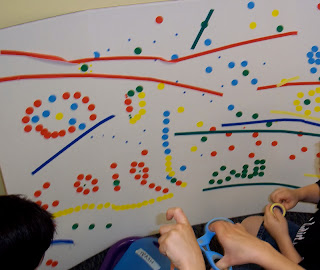I've been thinking a lot about intentional teaching and putting a few things out to show kids what I'm thinking they might do. I encourage kids to use their own ideas, but I'm learning that stimulating their thinking is important. And, they don't need to ask me what they "do here." (Teacher Tom and Sherry and Donna blog a lot about setting up activities in inviting ways.)
So I put out a couple of the river shapes end to end, with a few blue rocks on the river. I also had a word card out with "Jordan River" (since that was in the Bible story we were discussing). Boys came over and began to investigate what I had in the blocks center. Immediately a long river formed.
Animals began "wading" in the river. (This is the setting for our green chicken discussion.) The blue rocks I had placed on the river went gathered into another place in the river...and other rocks were added.
I watched the play change a couple of times. Then - through consensus or some other group thinking - the boys began building structures - one to hold the animals and one to hold the rocks. I say, "You are building a place for the animals and a place for the rocks."
The boys said, "This is the food." I looked thoughtful. "Oh," I said, "a place to store the food and a place for the animals to live."
"Yes," they said. "Then when it's time to eat, we can put the food in with the animals."
When I came back to the blocks center, it was feeding time.
I watched the boys pour handfuls of rocks in with the animals. Rebuild and rearrange structures and resort the animals and rocks. And do the whole thing again.
Then, later, the structure developed into a place for both, with separate sections.
Lots of cooperative thinking and working. I could overhear some discussions about what needed to be done where. And steps to accomplish the tasks.
While the play didn't develop like last time...or like I was thinking when I put things out...I was pleased that the kids made the activity their own. The rocks became food (their idea). The river continued to flow alongside the structures, but the kids really didn't incorporate it into their play much (at least that I witnessed).
The play may have taken a different course, but the learning was still there. And, later when we talked about the river and moving all those animals, the boys had some ideas about that, too.




















































